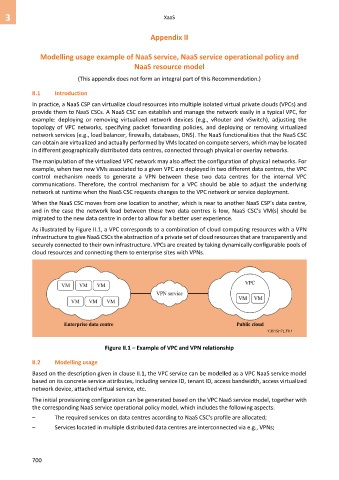Page 708 - Cloud computing: From paradigm to operation
P. 708
3 XaaS
Appendix II
Modelling usage example of NaaS service, NaaS service operational policy and
NaaS resource model
(This appendix does not form an integral part of this Recommendation.)
II.1 Introduction
In practice, a NaaS CSP can virtualize cloud resources into multiple isolated virtual private clouds (VPCs) and
provide them to NaaS CSCs. A NaaS CSC can establish and manage the network easily in a typical VPC, for
example: deploying or removing virtualized network devices (e.g., vRouter and vSwitch), adjusting the
topology of VPC networks, specifying packet forwarding policies, and deploying or removing virtualized
network services (e.g., load balancer, firewalls, databases, DNS). The NaaS functionalities that the NaaS CSC
can obtain are virtualized and actually performed by VMs located on compute servers, which may be located
in different geographically distributed data centres, connected through physical or overlay networks.
The manipulation of the virtualized VPC network may also affect the configuration of physical networks. For
example, when two new VMs associated to a given VPC are deployed in two different data centres, the VPC
control mechanism needs to generate a VPN between these two data centres for the internal VPC
communications. Therefore, the control mechanism for a VPC should be able to adjust the underlying
network at runtime when the NaaS CSC requests changes to the VPC network or service deployment.
When the NaaS CSC moves from one location to another, which is near to another NaaS CSP's data centre,
and in the case the network load between these two data centres is low, NaaS CSC's VM(s) should be
migrated to the new data centre in order to allow for a better user experience.
As illustrated by Figure II.1, a VPC corresponds to a combination of cloud computing resources with a VPN
infrastructure to give NaaS CSCs the abstraction of a private set of cloud resources that are transparently and
securely connected to their own infrastructure. VPCs are created by taking dynamically configurable pools of
cloud resources and connecting them to enterprise sites with VPNs.
Figure II.1 – Example of VPC and VPN relationship
II.2 Modelling usage
Based on the description given in clause II.1, the VPC service can be modelled as a VPC NaaS service model
based on its concrete service attributes, including service ID, tenant ID, access bandwidth, access virtualized
network device, attached virtual service, etc.
The initial provisioning configuration can be generated based on the VPC NaaS service model, together with
the corresponding NaaS service operational policy model, which includes the following aspects:
– The required services on data centres according to NaaS CSC's profile are allocated;
– Services located in multiple distributed data centres are interconnected via e.g., VPNs;
700

